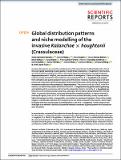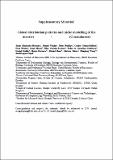Por favor, use este identificador para citar o enlazar a este item:
http://hdl.handle.net/10261/201593COMPARTIR / EXPORTAR:
 SHARE SHARE
 CORE
BASE CORE
BASE
|
|
| Visualizar otros formatos: MARC | Dublin Core | RDF | ORE | MODS | METS | DIDL | DATACITE | |

| Título: | Global distribution patterns and niche modelling of the invasive Kalanchoe × houghtonii (crassulaceae) |
Autor: | Herrando Moraira, Sonia CSIC ORCID ; Vitales, Daniel CSIC ORCID ; Nualart, Neus CSIC ORCID ; Gómez-Bellver, Carlos CSIC ORCID; Ibáñez Cortina, Neus CSIC ORCID ; Massó, Sergi CSIC ORCID ; Cachón, Pilar; González Gutiérrez, Pedro A.; Guillot Ortiz, Daniel; Herrera, Ileana; Shaw, Daniel; Stinca, Adriano; Wang, Zhiqiang; López-Pujol, Jordi CSIC ORCID | Fecha de publicación: | 21-feb-2020 | Editor: | Springer Nature | Citación: | Scientific Reports 10: 3143 (2020) | Resumen: | Invasive alien species are currently considered one of the main threats to global biodiversity. One of the most rapidly expanding invasive plants in recent times is Kalanchoe × houghtonii (Crassulaceae), an artificial hybrid created in the 1930s in the United States by experimental crossings between K. daigremontiana and K. tubiflora, two species endemic to Madagascar. Thanks to its large colonizing capacity (mainly derived from the production of asexual plantlets), K. × houghtonii soon escaped from cultivation and quickly spread in many parts of the world. However, its actual range is not well known due to the lack of a formal description until recent times (2006) and its strong morphological resemblance with one of its parentals (K. daigremontiana). The present study was aimed, in the first instance, to delimit the present distribution area of K. × houghtonii at the global scale by gathering and validating all its occurrences and to track its colonization history. Currently, K. × houghtonii can be found on all continents except Antarctica, although it did not reach a global distribution until the 2000s. Its potential distribution, estimated with MaxEnt modelling software, is mainly centered in subtropical regions, from 20° to 40° of both northern and southern latitudes, mostly in areas with a high anthropogenic activity. Unexpectedly, concomitant to a poleward migration, future niche models suggest a considerable reduction of its range by up to one-third compared to the present, which might be related with the Crassulaceaean Acid Metabolism (CAM) of K. × houghtonii. Further research may shed light as to whether a decrease in potential habitats constitutes a general pattern for Crassulaceae and CAM plants. | Versión del editor: | https://doi.org/10.1038/s41598-020-60079-2 | URI: | http://hdl.handle.net/10261/201593 | DOI: | 10.1038/s41598-020-60079-2 | E-ISSN: | 2045-2322 |
| Aparece en las colecciones: | (IBB) Artículos |
Ficheros en este ítem:
| Fichero | Descripción | Tamaño | Formato | |
|---|---|---|---|---|
| s41598-020-60079-2.pdf | 2,93 MB | Adobe PDF |  Visualizar/Abrir | |
| 41598_2020_60079_MOESM1_ESM.pdf | Supplementary information: supplementary material | 1,27 MB | Adobe PDF |  Visualizar/Abrir |
| 41598_2020_60079_MOESM2_ESM.xlsx | Supplementary information: appendix | 45,63 kB | Microsoft Excel XML | Visualizar/Abrir |
CORE Recommender
PubMed Central
Citations
9
checked on 17-abr-2024
SCOPUSTM
Citations
30
checked on 23-abr-2024
WEB OF SCIENCETM
Citations
27
checked on 23-feb-2024
Page view(s)
450
checked on 26-abr-2024
Download(s)
876
checked on 26-abr-2024

